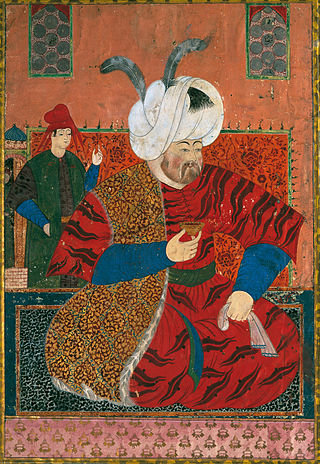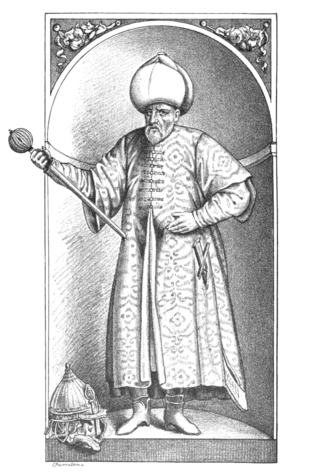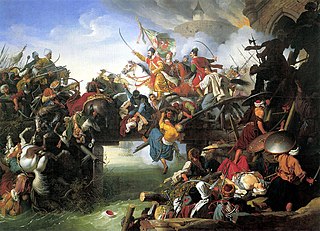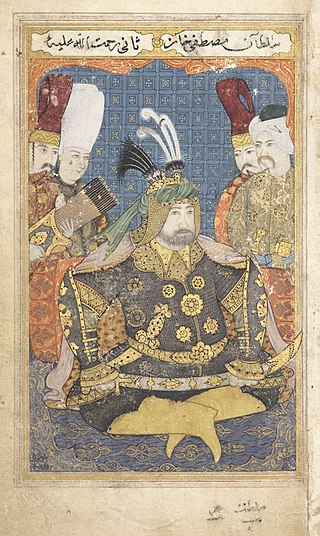
Ahmed II was the sultan of the Ottoman Empire from 1691 to 1695.

Selim II, also known as Selim the Blond or Selim the Drunkard, was the sultan of the Ottoman Empire from 1566 until his death in 1574. He was a son of Suleiman the Magnificent and his wife Hurrem Sultan. Selim had been an unlikely candidate for the throne until his brother Mehmed died of smallpox, his half-brother Mustafa was strangled to death by the order of his father and his brother Bayezid was killed on the order of his father after a rebellion against him and Selim.

Maximilian II was Holy Roman Emperor from 1564 until his death in 1576. A member of the Austrian House of Habsburg, he was crowned King of Bohemia in Prague on 14 May 1562 and elected King of Germany on 24 November 1562. On 8 September 1563 he was crowned King of Hungary and Croatia in the Hungarian capital Pressburg. On 25 July 1564 he succeeded his father Ferdinand I as Holy Roman Emperor.

Edirne, historically known as Adrianople, is a city in Turkey, in the northwestern part of the province of Edirne in Eastern Thrace. Situated 7 km (4.3 mi) from the Greek and 20 km (12 mi) from the Bulgarian borders, Edirne was the second capital city of the Ottoman Empire from 1369 to 1453, before Constantinople became its capital.

The Treaty of Karlowitz, concluding the Great Turkish War of 1683–1697, in which the Ottoman Empire was defeated by the Holy League at the Battle of Zenta, was signed in Karlowitz, in the Military Frontier of the Habsburg Monarchy, on 26 January 1699. Also known as "The Austrian treaty that saved Europe", it marks the end of Ottoman control in much of Central Europe, with their first major territorial losses in Europe, beginning the reversal of four centuries of expansion (1299–1683). The treaty established the Habsburg monarchy as the dominant power of the region.

Sokollu Mehmed Pasha was an Ottoman statesman of Serbian origin most notable for being the Grand Vizier of the Ottoman Empire. Born in Ottoman Herzegovina into an Orthodox Christian family, Mehmed was recruited as a young boy as part of so called "blood tax" to serve as a janissary to the Ottoman devşirme system of recruiting Christian boys to be raised as officers or administrators for the state. He rose through the ranks of the Ottoman imperial system, eventually holding positions as commander of the imperial guard (1543–1546), High Admiral of the Fleet (1546–1551), Governor-General of Rumelia (1551–1555), Third Vizier (1555–1561), Second Vizier (1561–1565), and as Grand Vizier under three sultans: Suleiman the Magnificent, Selim II, and Murad III. He was assassinated in 1579, ending his near 15-years of service to several Sultans, as sole legal representative in the administration of state affairs.

The siege of Szigetvár or the Battle of Szigeth was a siege of the fortress of Szigetvár, Kingdom of Hungary, that blocked Sultan Suleiman's line of advance towards Vienna in 1566. The battle was fought between the defending forces of the Habsburg monarchy under the leadership of Nikola IV Zrinski, former Ban of Croatia, and the invading Ottoman army under the nominal command of Sultan Suleiman the Magnificent.

The Peace of Zsitvatorok was a peace treaty which ended the 15-year Long Turkish War between the Ottoman Empire and the Habsburg monarchy on 11 November 1606. The treaty was part of a system of peace treaties which put an end to the anti-Habsburg uprising of Stephen Bocskai (1604–1606). The treaty was negotiated between 24 October and 11 November 1606 ad Situa Torock, at the former mouth of the Žitava River, which flows into the Danube in Royal Hungary. This location would later become the small settlement of Žitavská Tôňa, a part of the municipality of Radvaň nad Dunajom.
Treaty of Adrianople or Treaty of Edirne may refer to several treaties signed in Edirne :

The foreign relations of the Ottoman Empire were characterized by competition with the Persian Empire to the east, Russia to the north, and Austria to the west. The control over European minorities began to collapse after 1800, with Greece being the first to break free, followed by Serbia. Egypt was lost in 1798–1805. In the early 20th century Austria-Hungary annexed Bosnia and Herzegovina, the Bulgarian Declaration of Independence soon followed. The Ottomans lost nearly all their European territory in the First Balkan War (1912–1913). The Ottoman Empire allied itself with the Central Powers in the World War I, and was defeated. During the war, the British successfully mobilized Arab nationalism, and the Ottoman Empire thereby lost its Arab possessions, and itself soon collapsed in the early 1920s.

The Crusade of Varna was an unsuccessful military campaign mounted by several European leaders to check the expansion of the Ottoman Empire into Central Europe, specifically the Balkans between 1443 and 1444. It was called by Pope Eugene IV on 1 January 1443 and led by King Władysław III of Poland, John Hunyadi, Voivode of Transylvania, and Duke Philip the Good of Burgundy.

The Ottoman–Habsburg wars were fought from the 16th to the 18th centuries between the Ottoman Empire and the Habsburg monarchy, which was at times supported by the Kingdom of Hungary, Polish–Lithuanian Commonwealth, and Habsburg Spain. The wars were dominated by land campaigns in Hungary, including Transylvania and Vojvodina, Croatia, and central Serbia.

The Austro-Turkish War was fought in 1788–1791 between the Habsburg monarchy and the Ottoman Empire, concomitantly with the Russo-Turkish War (1787–1792), Russo-Swedish War (1788–1790) and Theatre War. It is sometimes referred to as the Habsburg–Ottoman War or the Austro-Ottoman War.

The Fourth Ottoman–Venetian War, also known as the War of Cyprus was fought between 1570 and 1573. It was waged between the Ottoman Empire and the Republic of Venice, the latter joined by the Holy League, a coalition of Christian states formed by the pope which included Spain, the Republic of Genoa, the Duchy of Savoy, the Knights Hospitaller, and the Grand Duchy of Tuscany.

The Franco-Ottoman alliance, also known as the Franco-Turkish alliance, was an alliance established in 1536 between Francis I, King of France and Suleiman I of the Ottoman Empire. The strategic and sometimes tactical alliance was one of the longest-lasting and most important foreign alliances of France, and was particularly influential during the Italian Wars. The Franco-Ottoman military alliance reached its peak with the Invasion of Corsica of 1553 during the reign of Henry II of France.
The territorial evolution of the Ottoman Empire spans seven centuries.
The Truce of Adrianople in 1547, named after the Ottoman city of Adrianople, was signed between Charles V and Suleiman the Magnificent. Through this treaty, Ferdinand I of Austria and Charles V recognized total Ottoman control of Hungary, and even agreed to pay to the Ottomans a yearly tribute of 30,000 gold florins for their Habsburg possessions in northern and western Hungary as a buffer for Vienna. The Treaty followed important Ottoman victories in Hungary, such as the siege of Esztergom (1543).

The Edirne Incident was a janissary revolt that began in Constantinople in 1703. The revolt was a reaction to the consequences of the Treaty of Karlowitz and Sultan Mustafa II's absence from the capital. The rising power of the Sultan’s former tutor, Şeyhülislam Feyzullah Efendi and the empire's declining economy caused by tax farming were also causes of the revolt. As a result of the Edirne Event, Şeyhülislam Feyzullah Efendi was killed, and Sultan Mustafa II was ousted from power. The Sultan was replaced by his brother, Sultan Ahmed III. The Edirne Event contributed to the decline of the power of the sultanate and the increasing power of the janissaries and kadis.
Jacobus Colyer was a Dutch politician and diplomat, who represented the Dutch Republic at the Sublime Porte.

The Ottoman-Habsburg War (1565-1568) was a conflict between the Habsburg Empire and the Ottoman Empire fought mainly on the territory of Hungary and Croatia. During the war, the Turks captured the castle at Szigetvár but the death of Sultan Suleiman I forced them to retreat. The war ended in 1568 after the signing of a peace treaty in Edirne, under which both sides retained their territorial gains, and the Habsburgs further pledged to pay tribute of 30,000 forints to the Turks.

















